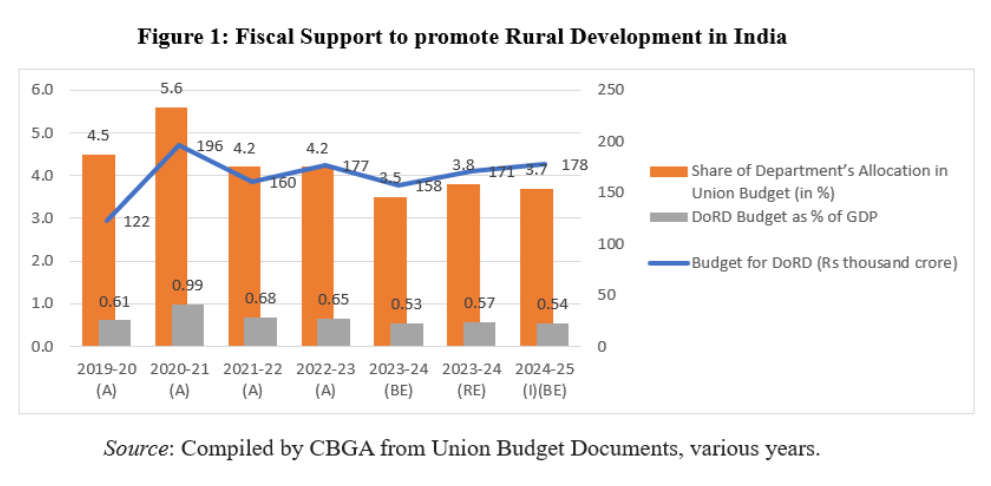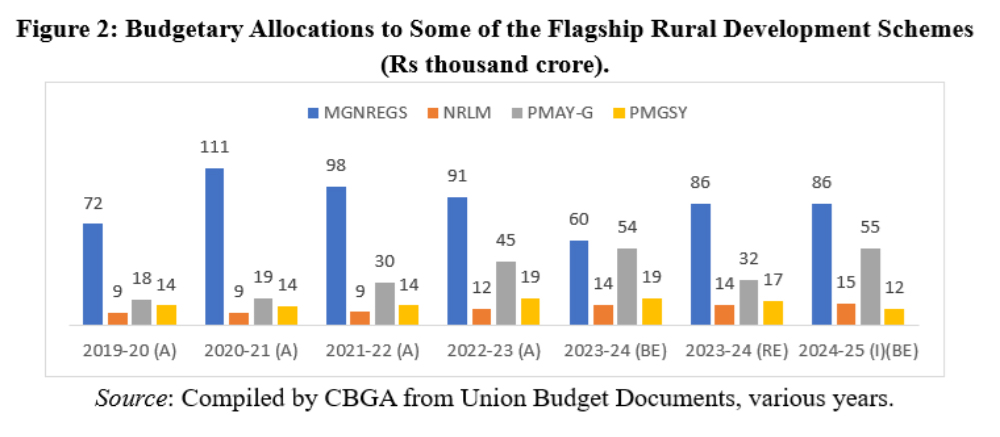The rural economy demonstrated remarkable resilience in absorbing the shock of reverse migration caused by the COVID-19 pandemic. However, it continues to face significant challenges due to high levels of poverty and socio-economic inequalities which were exacerbated by the pandemic.
In 2020-21, the department of rural development received its highest budgetary allocation in six years as the government tried to mitigate the immediate impact of the pandemic. Yet, in the years that followed, funding has largely plateaued, indicating limited resources for developmental activities in rural areas. The allocation for the department in 2024-25 is Rs 1,78,000 crore, marking a 12% increase from the previous year. Nonetheless, the allotment as the share of the GDP has been on a decline, despite the rural economy contributing nearly 30% to the national income.
READ | India bets big on natural gas, eyes 15% share in energy mix

The Economic Survey of 2022-23 suggested a multi-faceted approach to address these disparities and promote growth in the rural economy. It is crucial, therefore, to examine the Union government’s fiscal priorities for key schemes that have generated employment, expanded infrastructure and connectivity, and provided housing amenities in rural areas.
We are now on Whatsapp. Click to join
This article evaluates the effectiveness of budgetary allocations for major flagship programs like the Mahatma Gandhi National Rural Employment Guarantee Scheme (MGNREGS), Deen Dayal Upadhyay-National Rural Livelihoods Mission (DAY-NRLM), Pradhan Mantri Awaas Yojana-Grameen (PMAY-G), and Pradhan Mantri Gram Sadak Yojana (PMGSY), in boosting the rural economy.

The budget for MGNREGS has seen a significant 43% increase from the previous year, reflecting a response to the sustained high demand for work. This increase signifies the government’s recognition of the scheme’s role in promoting income diversification and enhancing rural livelihood resilience post-pandemic. Additionally, the proportion of women benefiting from the scheme has risen from approximately 54% in FY 2019-20 to 59% in FY 2023-24, highlighting its positive impact on the female workforce. Despite these achievements, issues such as pending wage payments remain, and the allocation trends over the years show that funding has been driven more by targets than actual demand.
We are now on Telegram. Click to join
The DAY-NRLM has been instrumental in increasing the labour force participation rate of rural women, from 19.7% in 2018-19 to 27.7% in 2020-21, thereby supporting women’s empowerment. Mobilising nine crore women and supporting approximately 83.5 lakh women’s self-help groups (SHGs) underline this success. However, the slight increase in the scheme’s allocation for 2024-25 may not suffice to broaden and diversify livelihood opportunities for rural women.
PMAY-G, aimed at achieving housing for all by 2022 (extended to March 2024), has made significant strides, with 2.93 crore houses sanctioned and 2.41 crore completed as of August 8, 2023. The government’s proposal to construct two crore additional houses over the next five years, accompanied by a 70% budget increase for 2024-25 compared with 2023-24, promises further employment and infrastructure development while expanding the beneficiary base.
PMGSY has been a cornerstone in improving rural infrastructure, sanctioning 8,15,072 km of roads and completing 7,51,163 km by January 2024. Despite this success, the reduced budget allocation raises concerns about quality control and the effective use of funds, particularly in areas yet to be covered.
While fiscal support for rural development appears adequate, the emphasis must shift toward the effective and efficient execution of these schemes. Addressing issues such as project delays, substandard materials, benefits to ineligible recipients, and low fund utilisation, especially in less developed states, is vital. Enhancing rural resilience requires not just financial investment but a committed effort to transform policies into tangible benefits for the rural populace.


 9 February 2024
9 February 2024